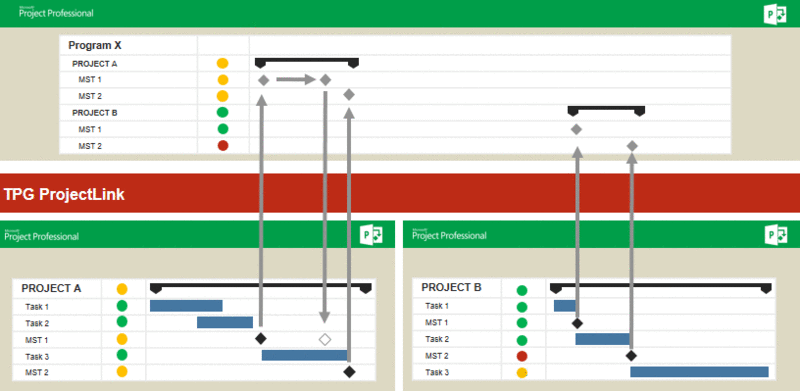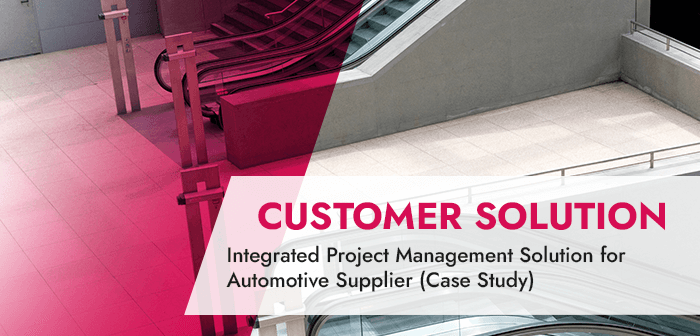Precision engineering company Alfmeier Präzision SE refers to the tiny components it makes with the inspiring phrase: “Small things set large ones in motion”.
Starting with small steps, a change of system supporting its project management organization has also moved the company forward, making it more efficient and competitive.
A key component of the enterprise project management solution is the bidirectional data synchronization between SAP and Microsoft Project, making cost and resource planning simpler and more accurate.
Our service for you: Get your copy of the Alfmeier integrated project management case study – DOWNLOAD PDF HERE!
A Quick Overview of this Customer Story
The Company: Alfmeier Präzision SE is a global manufacturer of precision system solutions using valves, actuators, pumps, and controllers. Based in Treuchtlingen (Germany) and with a global workforce of about 2,000 employees world-wide, its core competencies include plastic technology, electronics, mechatronics, fluid technology and industrial solutions. Alfmeier is a leading supplier to the automotive industry as well as medical technology and other sectors.
The Challenge: The company’s project managers were all using a mix of different project management solutions, including a variety of Microsoft Office applications. If a manager wanted an overview of project costs, he or she had to ask each project manager individually. This made cost and resource planning, as well as scheduling and reporting, difficult and time consuming.
The Solution: The project management solution is based on Microsoft Project Server, which TPG has customized with over 100 user-defined fields. As SAP is a central business solution at Alfmeier, the company has also implemented TPG PSLink to synchronize information between the project management and ERP systems. TPG ProjectLink is used for multi-level scheduling in the case of large-scale components with multiple sub-projects.
The Benefits: All aspects of project planning – including scheduling, resource planning, actual and planned costs, reporting and more – are significantly faster and more efficient since the company has been using the enterprise project management solution. It has saved time and money through across-the-board project visibility and accelerated reporting, while facilitating the firms’ capacity to complete even complex projects on time and on budget.
The Company Alfmeier Präzision SE
Alfmeier Präzision SE is a global high-tech company serving the automotive and other industries. With about 2000 employees worldwide, it is a recognized specialist in plastic injection molding and fluid systems as well as electronics, mechatronics and car seat solutions. The Fluid Systems business unit develops intelligent solutions for applications such as fuel supply, servo assistance, flap control, crank case ventilation as well as thermal management. The Seat Comfort division focuses on a range of advanced solutions for car seats that adapt to the anatomy of the vehicle’s occupants. The company is headquartered in Treuchtlingen (Germany) and has subsidiaries in the USA, Mexico, Czech Republic, China and Korea.
 Patchwork of Different Tools
Patchwork of Different Tools
With the implementation of SAP PS and other tools for project planning, the precision engineering company ended up using a plethora of different systems. Each project manager had their own preference, so if management wanted to know how a specific project – or even the overall project cost – was progressing, they had to ask each project manager individually.
Do you find this integrated project management case study helpful? Read other customer story about the integration of MS Project and SAP:
This was a particularly complex undertaking in Alfmeier’s case as the company operates in multiple different countries. Project managers would request and create projects in SAP PS, while documents produced by the teams during the course of the project work were in other formats, such as Word and Excel – particularly for cost estimates, proposal approvals and change requests.
The staff entered their timesheet information in SAP and managers produced reports in Excel, PowerPoint, Access and Word as well as APIS and QlikView. This made it challenging to consolidate all the information as a basis for planning and decision-making.
As each project manager was using his or her preferred planning and scheduling tool, there was no quick way to review the teams’ schedules and ensure optimal staff resource utilization.
Centralize and Streamline Project Planning
Erich Taube, Head of Project Management Office (PMO) at Alfmeier Präzision SE, headed up a team tasked with finding a suitable solution for streamlining and standardizing project planning processes.
Special Download: Advantages of MS Project Server / Project Online over MS Project Standard
Please click here to download the PDF and learn why you should prefer the server over the client version.
“With our fairly intensive use of Microsoft Office products, we thought Microsoft Project Server would be the best fit, so we set about looking for potential partners,” says Erich Taube.
“What really clinched it for TPG was their PSLink product for bidirectional data synchronization between SAP and Microsoft Project Server, along with their ability to customize Microsoft Project Server to our needs.”
Meeting specialists from The Project Group (TPG), Erich Taube and his team were impressed by their experience and their quick grasp of the project management situation at Alfmeier. The team drew up a matrix comparing the offerings of the various providers, and TPG came out clearly on top.
“But what really clinched it for TPG was their PSLink product for bidirectional data synchronization between SAP and Microsoft Project Server, along with their ability to customize Microsoft Project Server to our needs,” adds Taube.
Customized Functionality
The first step was for everyone involved to get round a table and define the project’s specifications and goals. This was followed by the implementation of a test system to run alongside the production system on both the Microsoft Project and SAP sides.
The two teams worked together to implement over 100 user-defined fields in Microsoft Project, mainly SAP-related. Alfmeier staff ran a sample project through the systems to test both sides, including the planning process as well as schedules and costs.
 TPG was then tasked with developing a custom function for Alfmeier’s project managers. “We wanted a profitability indicator, updated in real time, to enable project managers to see at a glance how profitable their projects were,” comments Erich Taube. That way, project staff could work with their familiar tool without needing any expertise in the use of SAP. TPG developed the custom feature and implemented it together with the rest of the system. On the Alfmeier side, Erich Taube and his team facilitated user acceptance by organizing multiple training courses.
TPG was then tasked with developing a custom function for Alfmeier’s project managers. “We wanted a profitability indicator, updated in real time, to enable project managers to see at a glance how profitable their projects were,” comments Erich Taube. That way, project staff could work with their familiar tool without needing any expertise in the use of SAP. TPG developed the custom feature and implemented it together with the rest of the system. On the Alfmeier side, Erich Taube and his team facilitated user acceptance by organizing multiple training courses.
“We’re really pleased with the new EPM system, as it standardizes the entire planning procedure. We’ve set up a project cockpit that enables us to see the status of every project at the click of a mouse.”
They also designated individuals in the PMO who could intervene immediately in case of any problems in the field. In addition, the team supports several power users in the local offices who are able to help their colleagues quickly when queries arise.
Result: Production System Running Well
The production system has been running smoothly since May 2016 and supports all new projects. Although the previous system is still being used to support some older projects, it will gradually be retired once these projects are completed.
Erich Taube believes this stage will be reached by the end of 2017. “We’re really pleased with the new Microsoft PPM system, as it standardizes the entire planning procedure. We’ve set up a project cockpit that enables us to see the status of every project at the click of a mouse,” he says.
Interested in other customer solutions? Pick one from this list of case studies.
The bidirectional synchronization between Microsoft Project and SAP, based on TPG PSLink, is also running satisfactorily. It sends project information, WBS elements, actual hours and planned costs from Microsoft Project to SAP; and actual costs, profitability information and resource updates from SAP to Microsoft Project.
TPG ProjectLink is used for multi-level scheduling. As a Microsoft Project Server extension, this product enables cross-project links. These are used for large-scale components handled in a master plan and several sub-plans. The master plan contains the requirements which the sub-project managers have to observe. The information from the sub-plans is reported back to the masterplan.
 Benefits of the New Solution
Benefits of the New Solution
“The solution’s main benefit to our business is clearly better and more efficient planning, which in turn helps us ensure we complete our projects on time and on budget,” notes Erich Taube.
“We also save a lot of time on reporting, as we no longer need to ask each project manager individually to produce a report – we simply roll them all up together as everyone’s using the same system.” These reports compare actual costs, profitability information and completed milestones. They also visualize the differences between target and actual values with a traffic light display.
The PMO also has more visibility into the workloads of project managers and teams, another factor that contributes to better planning.
“We also save a lot of time on reporting, as we no longer need to ask each project manager individually to produce a report – we simply roll them all up together as everyone’s using the same system.”

Alfmeier has about 100 projects in the new system, of which approximately 60 are running in parallel. Around 80% of the projects comprise 300-350 tasks.
Huge time savings in reporting were also the key benefit in this Project Online Case Study.
“The larger ones can have up to 1000 tasks, so the new enterprise project management solution is essential to help us ensure these complex projects are completed efficiently from a cost and resourcing point of view,” adds Taube.
Next Steps
Erich Taube and his team are expanding usage of the project management system to more users – there are currently around 35 people using Microsoft Project Client and 150 using Project Web App – while increasing the number of projects running on the system.
Struggling with resource planning? Read about Resource Planning in Project Management.
“We’ve started with fairly small steps to ensure we got things right before extending it to a large group of users,” concludes Erich Taube. “As we say at Alfmeier, it’s small things that set large ones in motion!”
Have you been in a similar situation with your company? How did you resolve it? We look forward to receiving your comments below.






